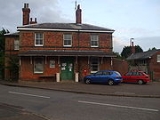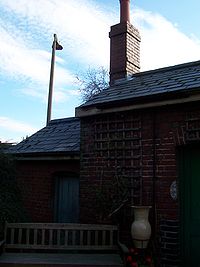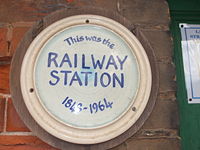
Wells-On-Sea railway station
Encyclopedia
Wells-next-the-Sea railway station served the small seaside port of Wells-next-the-Sea
in North Norfolk
, England
. It was opened in 1857 by the Wells & Fakenham Railway, later part of the Great Eastern Railway
's Wymondham to Wells branch
, and became a junction in 1866 with the arrival of the West Norfolk Junction Railway. It closed in 1964.
 Wells was first linked with the railway in 1857 when the Wells & Fakenham Railway opened a line to , largely driven by the efforts of Lord Leicester
Wells was first linked with the railway in 1857 when the Wells & Fakenham Railway opened a line to , largely driven by the efforts of Lord Leicester
and the directors of the railway company. They hoped that the railway, to be worked by the Eastern Counties Railway
, would help reverse the declining fortunes of the town, whose inability to take ships of increasing size saw it overtaken by other ports. The decline continued notwithstanding the construction of a short branch line to Wells Harbour
in 1860. In 1862, the Wells & Fakenham Railway became part of the Great Eastern Railway, a move which brought greater importance to the Wells line by providing a north-south connection with London
's increasing food markets.
The West Norfolk Junction Railway was the next to come to Wells, in August 1866. The line came from on a 18½ mile single track aimed at exploiting the great arc of coastline between Hunstanton
and Yarmouth
. This line entered Wells on a sharp curve, turning through a full 180 degrees before converging with the Wells & Fakenham branch from for the final approach. West Norfolk services used the outer face of a sheltered wooden island platform
to the south of the station, with the inner face for services to Dereham and . The Dereham side was unusual in that there was a platform on either side of the train, allowing the passengers the choice of which side to alight from, much the same as and stations.
station buildings were constructed at right angles to the platform ends and incorporated a stationmaster's residence.
Wells had a combined engine shed
and goods shed
, with the locomotives having use of the whole shed when not required for goods. This adjoined the main station building on the West Norfolk Junction platform side. In 1929 the original 42' turntable was replaced by a second-hand 45' version. This lay just to the north of the station, and was capable of accommodating the former Great Eastern's "Claud Hamilton" locomotives and other 4-4-0
classes, but not the B12s
or other large engines. Wells was an outstation of Norwich depot, and there were up to five locomotives based there. The shed officially closed in September 1955 and has since been demolished.
 Wells was a busy terminal station for almost 100 years, with a dozen or so passenger trains calling each day and goods trains from the harbour. Messrs Dewing & Kersley opened a corn mill adjacent to the station in 1904, and the smell of animal feedstuffs often wafted into the station to mix with the smoke, steam and hot oil odours given off by the locomotives, and the fishy smells coming from the 'Stiffkey Blues' cockles
Wells was a busy terminal station for almost 100 years, with a dozen or so passenger trains calling each day and goods trains from the harbour. Messrs Dewing & Kersley opened a corn mill adjacent to the station in 1904, and the smell of animal feedstuffs often wafted into the station to mix with the smoke, steam and hot oil odours given off by the locomotives, and the fishy smells coming from the 'Stiffkey Blues' cockles
loaded into the guards' vans of trains.
The post-war boom experienced by the King's Lynn to Hunstanton line was not felt on the West Norfolk Junction Railway, whose inconveniently-sited stations contributed to declining passenger traffic. Passenger services between Wells and Heacham were withdrawn from 31 May 1952, but the line remained open to freight. In the North Sea flood of 1953
, the track between Wells and was so severely damaged that British Railways
considered it not worth repairing and the line was closed completely between these two places. The station closed a little over ten years later when the line from Dereham to Wells closed to passenger traffic on 5 October 1964.
. This station is to the south of where the original line crossed the main coast road on the level.
Wells-next-the-Sea
Wells-next-the-Sea, known locally simply as Wells, is a town, civil parish and seaport situated on the North Norfolk coast in England.The civil parish has an area of and in the 2001 census had a population of 2,451 in 1,205 households...
in North Norfolk
North Norfolk
North Norfolk is a local government district in Norfolk, United Kingdom. Its council is based in Cromer. The council headquarters can be found approximately out of the town of Cromer on the Holt Road.-History:...
, England
England
England is a country that is part of the United Kingdom. It shares land borders with Scotland to the north and Wales to the west; the Irish Sea is to the north west, the Celtic Sea to the south west, with the North Sea to the east and the English Channel to the south separating it from continental...
. It was opened in 1857 by the Wells & Fakenham Railway, later part of the Great Eastern Railway
Great Eastern Railway
The Great Eastern Railway was a pre-grouping British railway company, whose main line linked London Liverpool Street to Norwich and which had other lines through East Anglia...
's Wymondham to Wells branch
Wymondham to Wells branch
The Wymondham to Wells branch was a railway built in stages by the Norfolk Railway and Eastern Counties Railway between 1847 and 1857. The railway ran from Wymondham in the south, through Dereham and Fakenham to the coastal town of Wells-next-the-Sea; more specifically, the line ran from Wymondham...
, and became a junction in 1866 with the arrival of the West Norfolk Junction Railway. It closed in 1964.
Opening

Thomas Coke, 2nd Earl of Leicester
Thomas William Coke, 2nd Earl of Leicester KG , known as Viscount Coke from 1837 to 1842, was a British peer....
and the directors of the railway company. They hoped that the railway, to be worked by the Eastern Counties Railway
Eastern Counties Railway
The Eastern Counties Railway was an early English railway company incorporated in 1836. It was intended to link London with Ipswich via Colchester, and then on to Norwich and Yarmouth. Construction began in late March 1837 on the first nine miles, at the London end of the line.Construction was...
, would help reverse the declining fortunes of the town, whose inability to take ships of increasing size saw it overtaken by other ports. The decline continued notwithstanding the construction of a short branch line to Wells Harbour
Wells Harbour
Wells Harbour is located in the town of Wells-next-the-Sea in the county of Norfolk, England . The harbour is 21 miles west of Cromer, 34.8 miles north of Norwich and 123 miles north of London. The harbour lies north of the A149 between King’s Lynn and Great Yarmouth...
in 1860. In 1862, the Wells & Fakenham Railway became part of the Great Eastern Railway, a move which brought greater importance to the Wells line by providing a north-south connection with London
London
London is the capital city of :England and the :United Kingdom, the largest metropolitan area in the United Kingdom, and the largest urban zone in the European Union by most measures. Located on the River Thames, London has been a major settlement for two millennia, its history going back to its...
's increasing food markets.
The West Norfolk Junction Railway was the next to come to Wells, in August 1866. The line came from on a 18½ mile single track aimed at exploiting the great arc of coastline between Hunstanton
Hunstanton
Hunstanton, often pronounced by locals as and known colloquially as 'Sunny Hunny', is a seaside town in Norfolk, England, facing The Wash....
and Yarmouth
Great Yarmouth
Great Yarmouth, often known to locals as Yarmouth, is a coastal town in Norfolk, England. It is at the mouth of the River Yare, east of Norwich.It has been a seaside resort since 1760, and is the gateway from the Norfolk Broads to the sea...
. This line entered Wells on a sharp curve, turning through a full 180 degrees before converging with the Wells & Fakenham branch from for the final approach. West Norfolk services used the outer face of a sheltered wooden island platform
Island platform
An island platform is a station layout arrangement where a single platform is positioned between two tracks within a railway station, tram stop or transitway interchange...
to the south of the station, with the inner face for services to Dereham and . The Dereham side was unusual in that there was a platform on either side of the train, allowing the passengers the choice of which side to alight from, much the same as and stations.
Station facilities
The main red brick two-storey 'L' shaped Georgian-styleGeorgian architecture
Georgian architecture is the name given in most English-speaking countries to the set of architectural styles current between 1720 and 1840. It is eponymous for the first four British monarchs of the House of Hanover—George I of Great Britain, George II of Great Britain, George III of the United...
station buildings were constructed at right angles to the platform ends and incorporated a stationmaster's residence.
Wells had a combined engine shed
Motive power depot
Motive power depot, usually abbreviated to MPD, is a name given to places where locomotives are stored when not being used, and also repaired and maintained. They were originally known as "running sheds", "engine sheds", or, for short, just sheds. Facilities are provided for refuelling and...
and goods shed
Goods shed
A goods shed is a railway building designed for storing goods before or after carriage in a train.A typical goods shed will have a track running through it to allow goods wagons to be unloaded under cover, although sometimes they were built alongside a track with possibly just a canopy over the door...
, with the locomotives having use of the whole shed when not required for goods. This adjoined the main station building on the West Norfolk Junction platform side. In 1929 the original 42' turntable was replaced by a second-hand 45' version. This lay just to the north of the station, and was capable of accommodating the former Great Eastern's "Claud Hamilton" locomotives and other 4-4-0
4-4-0
Under the Whyte notation for the classification of steam locomotives, 4-4-0 represents the wheel arrangement of four leading wheels on two axles , four powered and coupled driving wheels on two axles, and no trailing wheels...
classes, but not the B12s
GER Class S69
Great Eastern Railway Class S69, also known as 1500 Class, and later classified B12 by the LNER is a class of 4-6-0 steam locomotive designed for passenger work. Originally they were designed by S. D. Holden, but were much rebuilt, resulting in several subclasses.Seventy-one S69 locomotives were...
or other large engines. Wells was an outstation of Norwich depot, and there were up to five locomotives based there. The shed officially closed in September 1955 and has since been demolished.
Operations

Cockle (bivalve)
Cockle is the common name for a group of small, edible, saltwater clams, marine bivalve molluscs in the family Cardiidae.Various species of cockles live in sandy sheltered beaches throughout the world....
loaded into the guards' vans of trains.
The post-war boom experienced by the King's Lynn to Hunstanton line was not felt on the West Norfolk Junction Railway, whose inconveniently-sited stations contributed to declining passenger traffic. Passenger services between Wells and Heacham were withdrawn from 31 May 1952, but the line remained open to freight. In the North Sea flood of 1953
North Sea flood of 1953
The 1953 North Sea flood was a major flood caused by a heavy storm, that occurred on the night of Saturday 31 January 1953 and morning of 1 February 1953. The floods struck the Netherlands, Belgium, England and Scotland.A combination of a high spring tide and a severe European windstorm caused a...
, the track between Wells and was so severely damaged that British Railways
Eastern Region of British Railways
The Eastern Region was a region of British Railways from 1948. The region ceased to be an operating unit in its own right in the 1980s and was wound up at the end of 1992...
considered it not worth repairing and the line was closed completely between these two places. The station closed a little over ten years later when the line from Dereham to Wells closed to passenger traffic on 5 October 1964.
Present day
In 2007 the station building was a second-hand bookshop and pottery, with the site of the platforms an industrial estate known as Great Eastern Way. The old corn mill was used as a furniture warehouse, before being converted into flats. Part of the ground floor is occupied by Wells Antiques Centre and Glaven Veterinary Centre.Wells and Walsingham Light Railway
Since 1982, there has been a second station at Wells, the terminus of the narrow gauge Wells and Walsingham Light RailwayWells and Walsingham Light Railway
The Wells and Walsingham Light Railway is a gauge heritage railway in Norfolk, England running between the coastal town of Wells and Walsingham which is further inland...
. This station is to the south of where the original line crossed the main coast road on the level.

